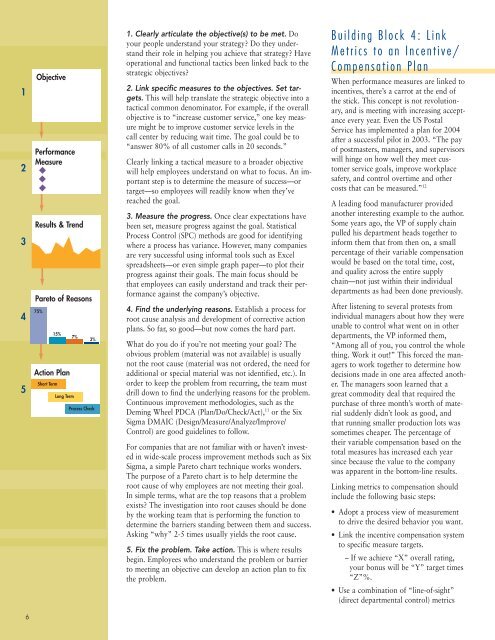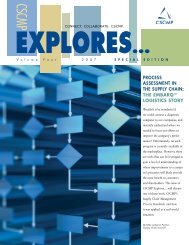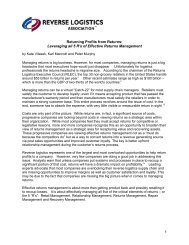is your metrics program measuring up? - Supply Chain Visions
is your metrics program measuring up? - Supply Chain Visions
is your metrics program measuring up? - Supply Chain Visions
Create successful ePaper yourself
Turn your PDF publications into a flip-book with our unique Google optimized e-Paper software.
1<br />
2<br />
3<br />
4<br />
5<br />
6<br />
Objective<br />
Performance<br />
Measure<br />
Results & Trend<br />
Pareto of Reasons<br />
75%<br />
15%<br />
Action Plan<br />
Short Term<br />
Long Term<br />
7%<br />
3%<br />
Process Check<br />
1. Clearly articulate the objective(s) to be met. Do<br />
<strong>your</strong> people understand <strong>your</strong> strategy? Do they understand<br />
their role in helping you achieve that strategy? Have<br />
operational and functional tactics been linked back to the<br />
strategic objectives?<br />
2. Link specific measures to the objectives. Set targets.<br />
Th<strong>is</strong> will help translate the strategic objective into a<br />
tactical common denominator. For example, if the overall<br />
objective <strong>is</strong> to “increase customer service,” one key measure<br />
might be to improve customer service levels in the<br />
call center by reducing wait time. The goal could be to<br />
“answer 80% of all customer calls in 20 seconds.”<br />
Clearly linking a tactical measure to a broader objective<br />
will help employees understand on what to focus. An important<br />
step <strong>is</strong> to determine the measure of success—or<br />
target—so employees will readily know when they’ve<br />
reached the goal.<br />
3. Measure the progress. Once clear expectations have<br />
been set, measure progress against the goal. Stat<strong>is</strong>tical<br />
Process Control (SPC) methods are good for identifying<br />
where a process has variance. However, many companies<br />
are very successful using informal tools such as Excel<br />
spreadsheets—or even simple graph paper—to plot their<br />
progress against their goals. The main focus should be<br />
that employees can easily understand and track their performance<br />
against the company’s objective.<br />
4. Find the underlying reasons. Establ<strong>is</strong>h a process for<br />
root cause analys<strong>is</strong> and development of corrective action<br />
plans. So far, so good—but now comes the hard part.<br />
What do you do if you’re not meeting <strong>your</strong> goal? The<br />
obvious problem (material was not available) <strong>is</strong> usually<br />
not the root cause (material was not ordered, the need for<br />
additional or special material was not identified, etc.). In<br />
order to keep the problem from recurring, the team must<br />
drill down to find the underlying reasons for the problem.<br />
Continuous improvement methodologies, such as the<br />
Deming Wheel PDCA (Plan/Do/Check/Act), 11 or the Six<br />
Sigma DMAIC (Design/Measure/Analyze/Improve/<br />
Control) are good guidelines to follow.<br />
For companies that are not familiar with or haven’t invested<br />
in wide-scale process improvement methods such as Six<br />
Sigma, a simple Pareto chart technique works wonders.<br />
The purpose of a Pareto chart <strong>is</strong> to help determine the<br />
root cause of why employees are not meeting their goal.<br />
In simple terms, what are the top reasons that a problem<br />
ex<strong>is</strong>ts? The investigation into root causes should be done<br />
by the working team that <strong>is</strong> performing the function to<br />
determine the barriers standing between them and success.<br />
Asking “why” 2-5 times usually yields the root cause.<br />
5. Fix the problem. Take action. Th<strong>is</strong> <strong>is</strong> where results<br />
begin. Employees who understand the problem or barrier<br />
to meeting an objective can develop an action plan to fix<br />
the problem.<br />
Building Block 4: Link<br />
Metrics to an Incentive/<br />
Compensation Plan<br />
When performance measures are linked to<br />
incentives, there’s a carrot at the end of<br />
the stick. Th<strong>is</strong> concept <strong>is</strong> not revolutionary,<br />
and <strong>is</strong> meeting with increasing acceptance<br />
every year. Even the US Postal<br />
Service has implemented a plan for 2004<br />
after a successful pilot in 2003. “The pay<br />
of postmasters, managers, and s<strong>up</strong>erv<strong>is</strong>ors<br />
will hinge on how well they meet customer<br />
service goals, improve workplace<br />
safety, and control overtime and other<br />
costs that can be measured.” 12<br />
A leading food manufacturer provided<br />
another interesting example to the author.<br />
Some years ago, the VP of s<strong>up</strong>ply chain<br />
pulled h<strong>is</strong> department heads together to<br />
inform them that from then on, a small<br />
percentage of their variable compensation<br />
would be based on the total time, cost,<br />
and quality across the entire s<strong>up</strong>ply<br />
chain—not just within their individual<br />
departments as had been done previously.<br />
After l<strong>is</strong>tening to several protests from<br />
individual managers about how they were<br />
unable to control what went on in other<br />
departments, the VP informed them,<br />
“Among all of you, you control the whole<br />
thing. Work it out!” Th<strong>is</strong> forced the managers<br />
to work together to determine how<br />
dec<strong>is</strong>ions made in one area affected another.<br />
The managers soon learned that a<br />
great commodity deal that required the<br />
purchase of three month’s worth of material<br />
suddenly didn’t look as good, and<br />
that running smaller production lots was<br />
sometimes cheaper. The percentage of<br />
their variable compensation based on the<br />
total measures has increased each year<br />
since because the value to the company<br />
was apparent in the bottom-line results.<br />
Linking <strong>metrics</strong> to compensation should<br />
include the following basic steps:<br />
• Adopt a process view of measurement<br />
to drive the desired behavior you want.<br />
• Link the incentive compensation system<br />
to specific measure targets.<br />
– If we achieve “X” overall rating,<br />
<strong>your</strong> bonus will be “Y” target times<br />
“Z”%.<br />
• Use a combination of “line-of-sight”<br />
(direct departmental control) <strong>metrics</strong>




